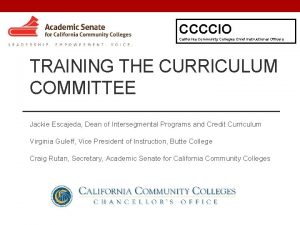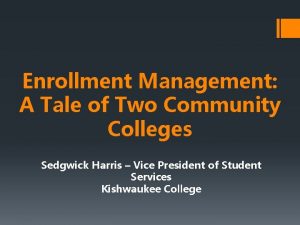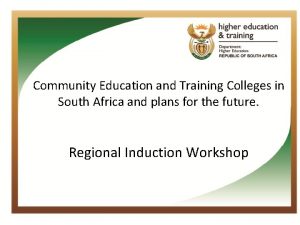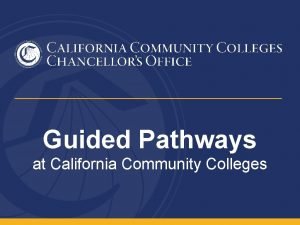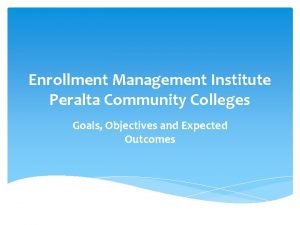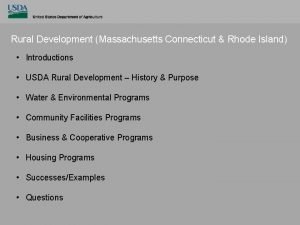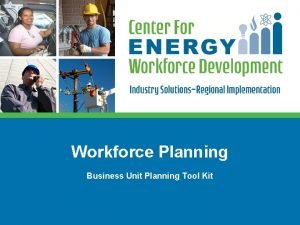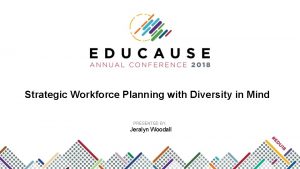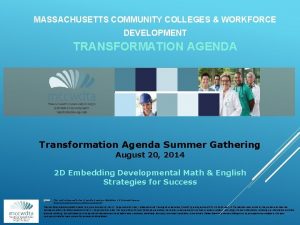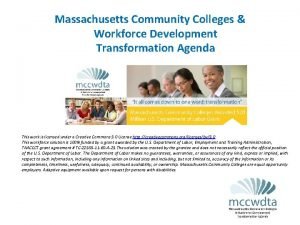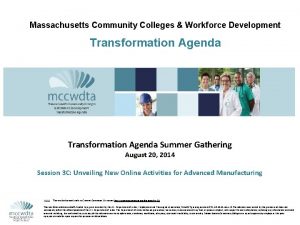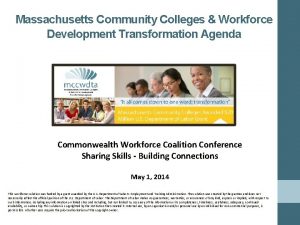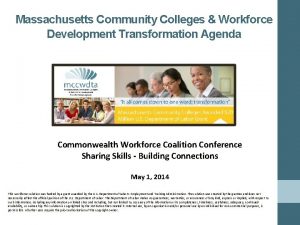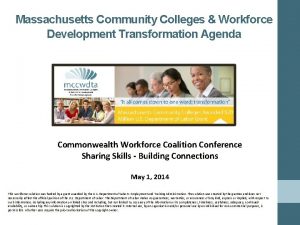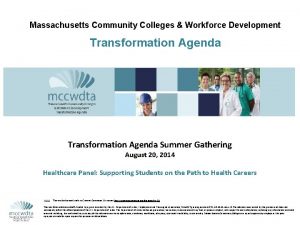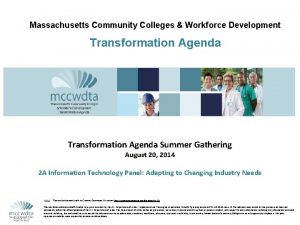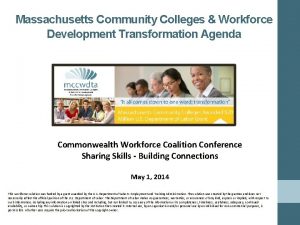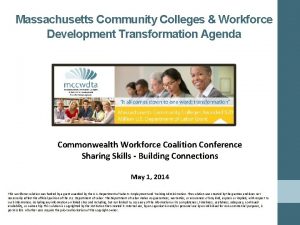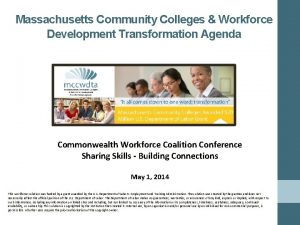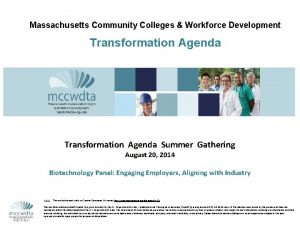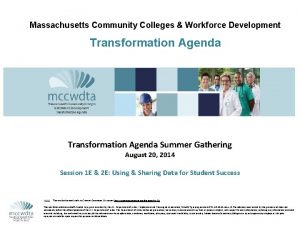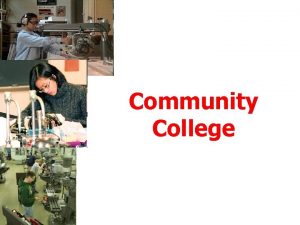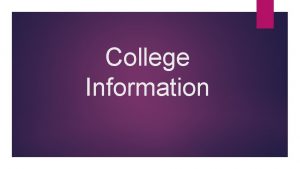Massachusetts Community Colleges Workforce Development Transformation Agenda Planning
















- Slides: 16

Massachusetts Community Colleges & Workforce Development Transformation Agenda Planning for Coordinated Job Placement OSCC and Community College Regional Meetings January – February 2014 This workforce solution is 100% funded by a grant awarded by the U. S. Department of Labor, Employment and Training Administration, TAACCCT grant agreement # TC-22505 -11 -60 -A-25. The solution was created by the grantee and does not necessarily reflect the official position of the U. S. Department of Labor. The Department of Labor makes no guarantees, warranties, or assurances of any kind, express or implied, with respect to such information, including any information on linked sites and including, but not limited to, accuracy of the information or its completeness, timeliness, usefulness, adequacy, continued availability, or ownership. Massachusetts Community Colleges are equal opportunity employers. Adaptive equipment available upon request for persons with disabilities. This work is licensed under a Creative Commons Attribution 3. 0 Unported License CCBY 3. 0 http: //creativecommons. org/licenses/by/3. 0

Unique Opportunities “This grant is not about tinkering, it’s about transformation. This is not about getting more students to enroll, it’s about getting more students to graduation day and into good jobs. ” - Arne Duncan, Secretary of Education

Proposal Overview • Budget funded is $20, 000 over 3 years to support capacitybuilding, systemic changes • Target population are un- and under-employed adult workers • Goal is to enroll 4, 000 students and place 2, 400 in employment over three years (statewide) • 15 colleges committed to statewide project with local implementation • Brings community colleges, Adult Basic Education and workforce development systems and industry stakeholders together to transform the delivery of education and training programs

Target Industries 15 Colleges, 98 new or redesigned programs in one or more industries: • Health Care • Advanced Manufacturing • Information Technologies • Life Sciences & Biotechnology • Clean/Sustainable Energy • Financial Services & Entrepreneurship

Transformation Agenda – Dual Goals Structural, Systematic Change • Redesign programs and services to accelerate attainment of certificates, degrees and employment for low-skilled, un- and under -employed MA residents. Student Attainment and Jobs • Enroll and track the progress of students through certificate/degree attainment & jobs.

Key Strategies Support students along efficient career pathways into high-demand careers. STUDENT SUPPORT Navigators at OSCCs Achievement coaches Intrusive advising CAREER PATHWAYS Modularized programs Accelerated developmental ed Stackable credentials HIGH DEMAND CAREERS Employer partnerships; Regional career paths Based on the core elements of the “Breaking Through” model

College and Career Navigators 16 working statewide at 30 One-Stop Career Centers Career Center Services College Access and Attainment Career Success

Other Student Support Services • Achievement coaches support student success through one-on-one academic, life and career coaching • Learning communities and other cohort models promote peer support and greater retention • “Intrusive” advising reaches more students with individualized support • Early-warning systems track student progress and allow for a coordinated response

Acceleration Strategies • Community colleges and community-based ABE programs use contextualized curriculum developed with industry input. • These help students advance on a career path more rapidly. Contextualized Basic Skills Curriculum Accelerated Developmental Education Stackable Credentials Flexible, Modular Schedules • Self-paced, embedded and corequisite models greatly reduce the time spent in remediation • 8 week terms and condensed formats help students complete programs and enter employment more quickly.

Expanded Employer Partnerships at all Community Colleges • Employer contributions • equipment and facilities • internships, clinical education, paid internships, onthe-job training • Colleges involved in regional partnerships are building talent pipelines across the state in major industry sectors

College & Career Navigators Results • Greater alignment between community colleges and workforce development system • Great expansion of community college programs on the “Training Pro” list of eligible programs • Joint tracking of customers through MOSES • College programs designed to fit training requirements for unemployed customers under “Section 30”

Career Center Services • Individual Assessment • Career Center. Needs Staff can help direct Career Center offers job assistance with: • Can help with online applications your job search • Interests (individual orpreparation workshop) (workshops) interviewworkshops • Résumé & 1 -on-1 • • Provide tips to find jobs that match skills • Knowledge, Skills, & Abilities ofofknowledge, • • Demonstrate use résumé to help fill out - Transferability finding resources for interview preparation Coveronletter workshops based LMI exploration • applications. Values or non-negotiables skills, abilities job how to use LMI to prepare fortointerview • Staff can help show you how • Industry/occupation trends • Direct you to job search resources • Hints andtotips and/or target yourworkshops résumé • use Pay. LMI trends • Show benefits of tracking job search • Job availability Assessment Labor Market Information (LMI) Where you are today Résumé & Cover Letter You are here Job Search Employm ent Apply for Jobs Interview 12

What is Labor Market Information? Are my skills still in demand? How do I develop my new skills or apply my newly acquired knowledge? How do I identify my transferrable skills? Are my wage expectations realistic? What jobs or industries are growing or declining? Where are the jobs? d nforme i e k a M ns decisio Market current skills and May connect relevant professional havewith to decide between commute Explore internships/externships/apprenticeships or companies that offer associations. best market toand enter given your skills and knowledge. work/life balance Attend. Identify LMI or the TORQ workshop strong mentorship programs. FIND THE RIGHT JOB Re-evaluate my expectations or transfer to growing industry *LMI is a requirement for REA participants 13

HI ER AR CH YO FN EE DS The Role of LMI EMPLOYMENT THE OFFER INTERVIEW JOB SEARCH RÉSUMÉ & WORKSHOPS LABOR MARKET INFORMATION CAREER TRANSITION 14

TORQ The TORQ Score* guides you to the best transfer options that match the skills and talents of your current occupation. *Transferable Occupation Relationship Quotient

16
 Role segmentation workforce planning
Role segmentation workforce planning Chief instructional officer
Chief instructional officer California community college chief instructional officers
California community college chief instructional officers Enrollment management models community colleges
Enrollment management models community colleges Community education and training colleges
Community education and training colleges Washington state board of technical and community colleges
Washington state board of technical and community colleges Cccco guided pathways
Cccco guided pathways Community colleges
Community colleges Association of canadian community colleges
Association of canadian community colleges Workforce transformation opwdd
Workforce transformation opwdd Rural development loan massachusetts
Rural development loan massachusetts Significance of human resource planning
Significance of human resource planning Workforce planning nedbank
Workforce planning nedbank Workforce tool set
Workforce tool set Talent analyst emsi
Talent analyst emsi Role segmentation workforce planning
Role segmentation workforce planning Pcmm
Pcmm

